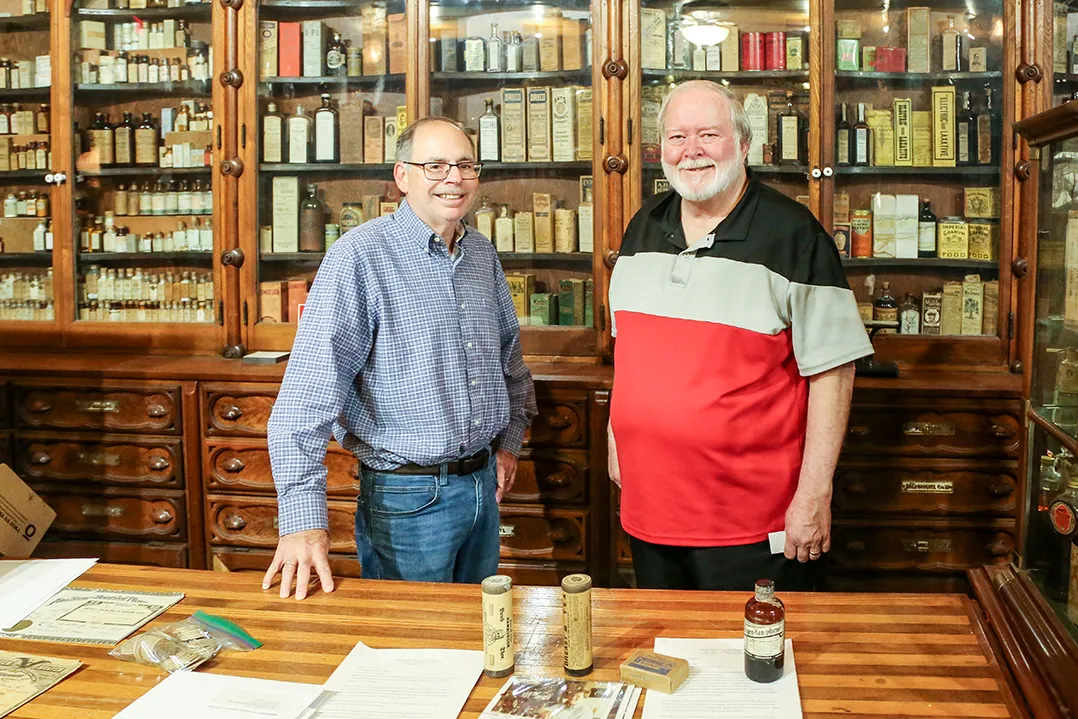When guests walk into the Hook’s Historical Drugstore Museum near the 38th Street entrance of the Indiana State Fairgrounds, they step back in time in more ways than one.
The museum, designed to replicate a late 19th-century drugstore, opened in 1966 as part of an effort to celebrate Indiana’s sesquicentennial anniversary of statehood. Nearly 60 years later, despite changing ownership several times, the expansive display of historic remedies, supplements and tools remains largely unchanged.
Now owned and operated by the nonprofit Hook’s Drugstore Museum, several Carmel residents who are current or former pharmacists are among board members keeping their profession’s history alive.
Bob Smith, a Carmel retiree who worked as a pharmacist and in the pharmaceutical industry, had been fascinated by the museum during visits to the state fair over the past 25 years and recently joined the nonprofit’s board.
“I stand on all of the pharmacists’ shoulders that came before me and worked in a place like this,” Smith said. “If I can keep this thing going for the next generation, I’d like to be part of that.”
‘A Gift to the State of Indiana’
The Hook’s Drugstore chain planned and launched the museum – originally set to be a three-month exhibit – as “A Gift to the State of Indiana,” according to Bud Hook, then the president of Hook Drug, Inc.
Hook, whose father launched the first Hook’s location in 1900, coordinated the project, asking pharmacists from around the state to contribute historical artifacts. He purchased the pre-Civil War walnut and ash cabinets still on display in the museum from a recently renovated pharmacy in Cambridge City and installed the original oak cabinets previously used at the first Hook’s drug store at 1101 S. East St. in Indianapolis.
The exhibit proved to be so popular (and won the Governor’s Prize for best corporate contribution to the Sesquicentennial) that organizers determined to bring it back the following year, and Hook’s became the main sponsor of the 1967 state fair. The museum has been a staple of the fair ever since.
The site operated as a Hook’s drug store location for many years until the fairgrounds installed a fence around its perimeter. Now, it’s only open to the public during the state fair, which this year runs Aug. 2 to 18 (closed Mondays). So, much of its funding is reliant on sales of candy, ice cream sodas and basic necessities during the 16 days of the fair.
Bob Hunt, a Hancock County resident who in 2004 helped launch the nonprofit that now owns the museum, said the historic drugstore is a popular stop for children visiting the fair.
“We pride ourselves on if you’ve got $1 to spend, we’ll sell you something,” Hunt said. “People will come in here and say, ‘I’ve only got a couple of dollars,’ but they can buy something.”
Hook’s, which at its peak operated 380 drug stores throughout Indiana and neighboring states, was bought by The Kroger Co. in 1987. Kroger divested the pharmacy to Revco seven years later, which operated them under the Revco brand until selling them to CVS in 1997.
What to expect
Bruce Clayton, a Carmel resident and museum board member, said his knowledge continues to expand when he visits the historic drug store.
“I’ve been doing this now for five years, and I’m still (discovering) things,” he said. “I enjoy working with all of it.”
During the fair, Clayton, a licensed pharmacist who spent much of his career in academia, is often on site to answer questions from visitors and provide demonstrations, such as how pills were made circa 1900.
Smith said the museum continues to add to its collection and will accept items from the late 1800s or early 1900s that are not part of its existing inventory. He is hoping for other forms of growth, as well.
“I’d like to see this remain the same or even get bigger and better, becoming a national pharmacy museum. I don’t know what exactly we’re going to be in 5, 10 or 15 years,” Smith said. “We’re only open for (two) weeks, but wouldn’t it be cool if we could make this an all-year thing, a bigger thing?”
Learn more at HooksMuseum.org.
The Triple C Float
Hook’s Historical Drug Store Museum is debuting the Chocolate Caramel Coffee Float, also known as The Triple C Float, at its soda fountain during the Indiana State Fair. The concoction, 24 ounces of iced coffee with ice cream, chocolate and caramel syrups topped with whipped cream and a cherry, is among 43 new state fair food and beverage items selected for this year’s Taste of the Fair competition.
Fairgoers can vote for their favorite “Taste of the Fair” items at info booths at the fairgrounds or by scanning QR codes at participating concession stands. The winning vendor will receive $2,500, with second and third place earning $1,000 and $500, respectively.
Learn more about Taste of the Fair at indianastatefair.com/p/state-fair/food–shopping/taste-of-the-fair.
